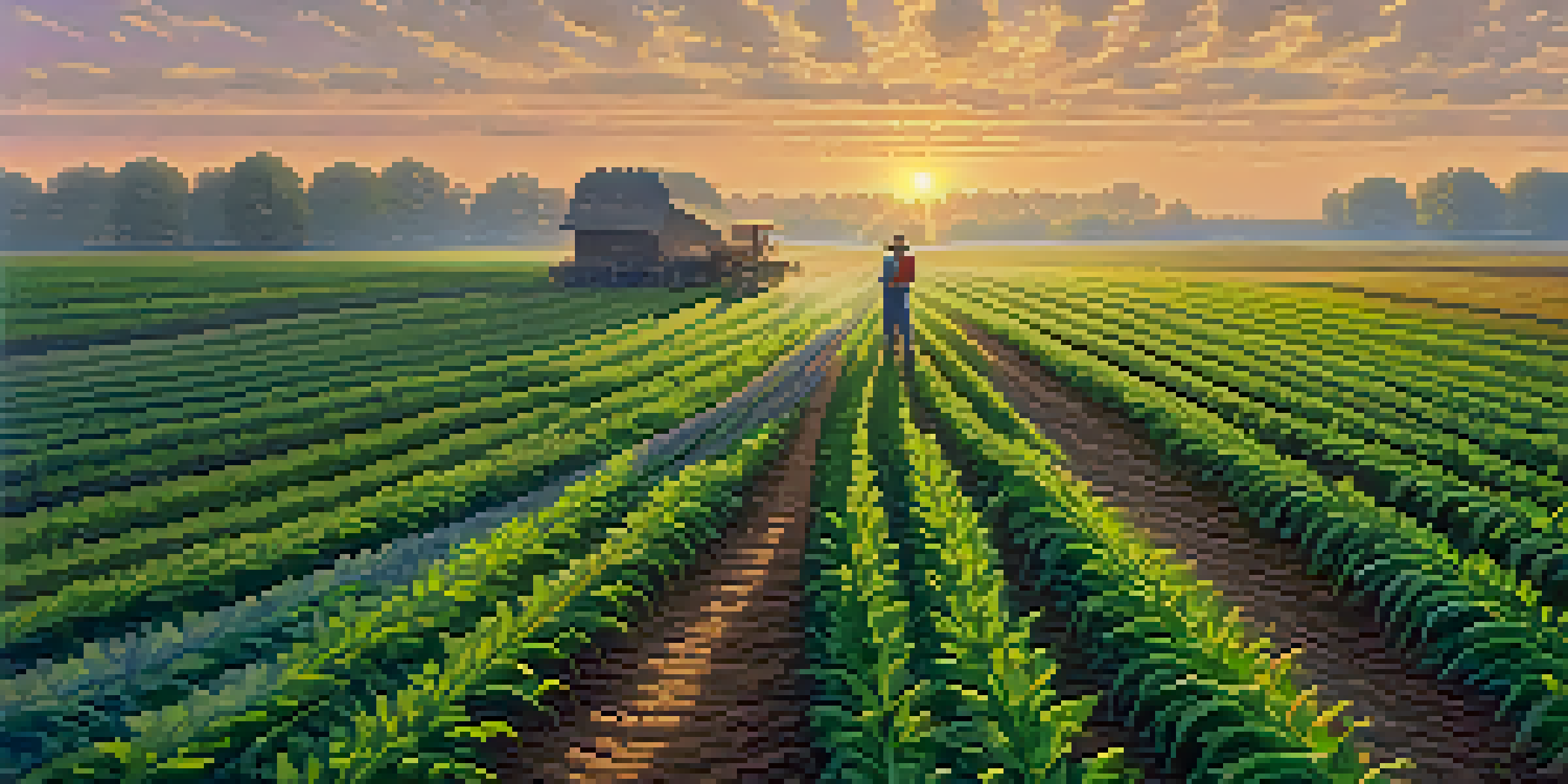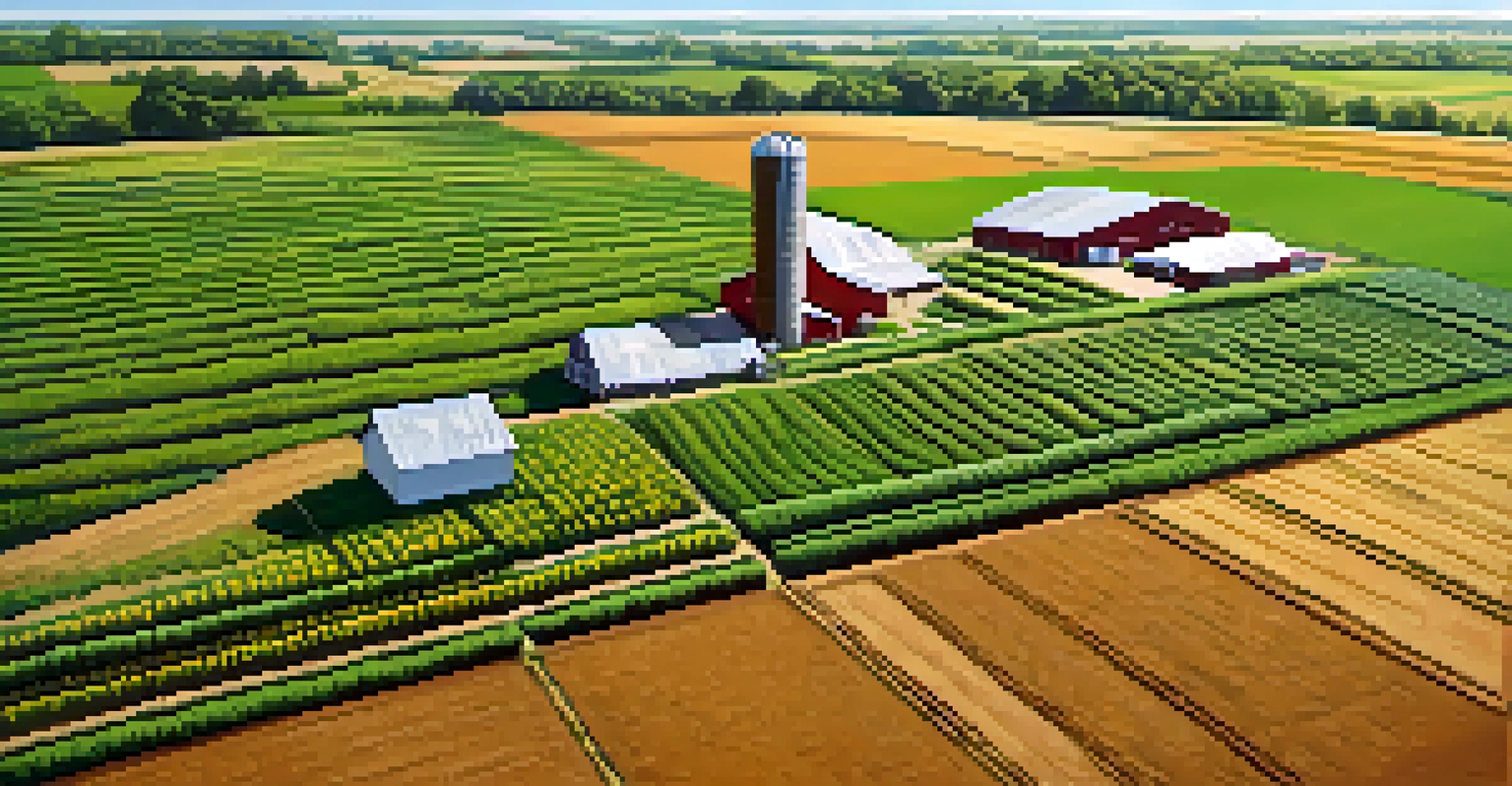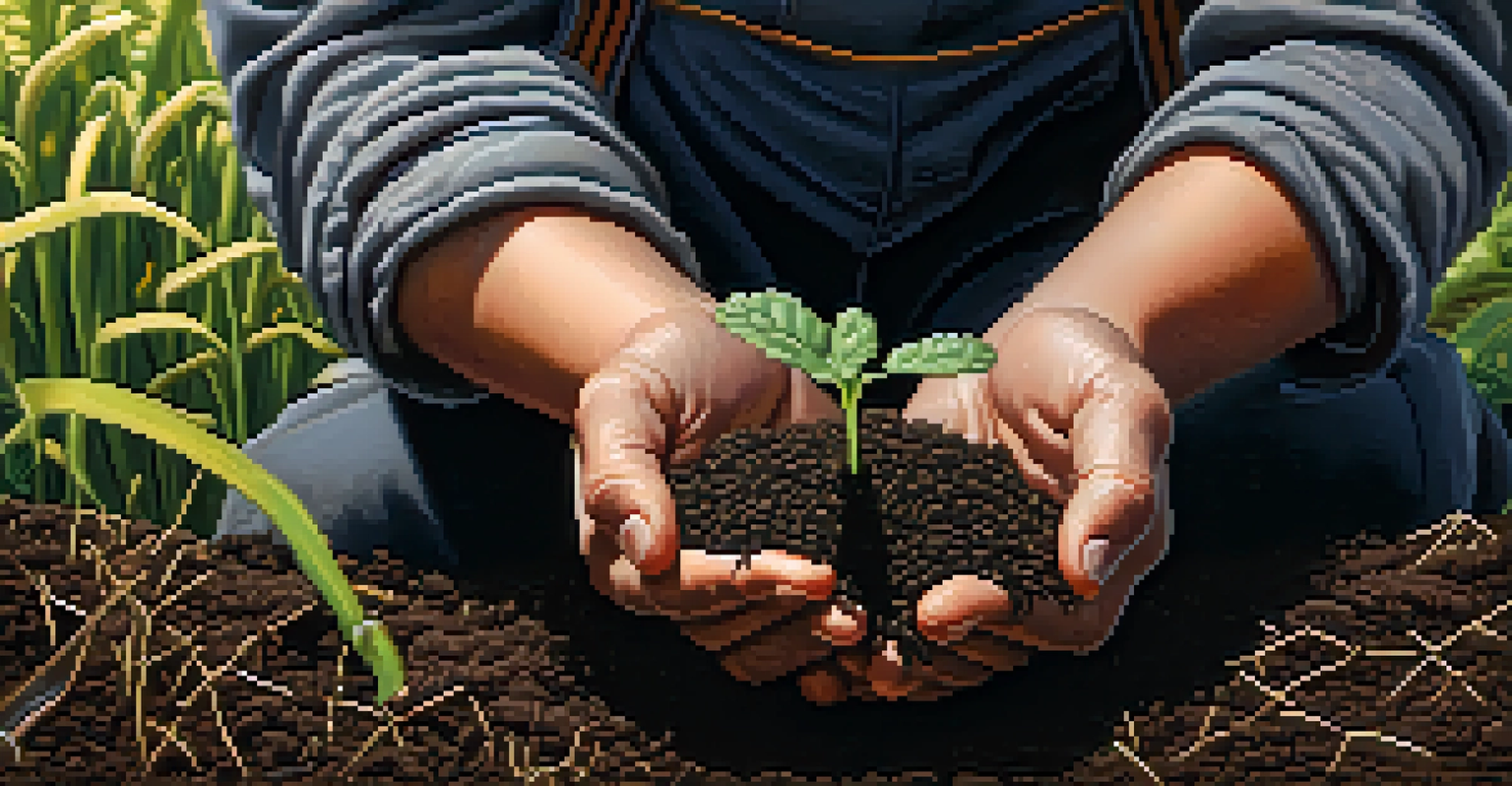Sustainable Agricultural Practices in Missouri Today

Understanding Sustainable Agriculture in Missouri
Sustainable agriculture refers to farming practices that meet the needs of the present without compromising future generations. In Missouri, this means implementing methods that are environmentally friendly, economically viable, and socially responsible. Farmers are increasingly recognizing the importance of sustainability as a way to enhance their resilience against climate change and market fluctuations.
Sustainable agriculture is a way of farming that works with nature, not against it.
The state's agricultural landscape is diverse, with crops like soybeans, corn, and rice dominating the scene. However, many farmers are now looking beyond traditional practices, aiming to balance productivity with ecological health. This shift is not just about preserving resources; it’s also about fostering a more vibrant farming community that thrives on innovation and care for the land.
By adopting sustainable practices, Missouri farmers are not only improving their yields but also contributing to the well-being of their communities. This holistic approach to agriculture is becoming more prevalent, showcasing how farmers can be stewards of the environment while still achieving economic success.
Crop Rotation: A Time-Tested Technique
One of the most effective sustainable practices is crop rotation, which involves alternating the types of crops grown on a particular piece of land. This method helps to improve soil health, reduce pest and disease cycles, and enhance biodiversity. In Missouri, farmers are embracing crop rotation to maintain the fertility of their fields while also maximizing productivity.

For instance, by rotating between soybeans and corn, farmers can break the cycle of pests that thrive on specific crops. This not only minimizes the need for chemical pesticides but also leads to healthier crops overall. As farmers share their experiences, more are discovering the benefits of this age-old practice, which is both simple and highly effective.
Sustainable Practices Enhance Resilience
Missouri farmers are adopting sustainable agriculture methods that improve productivity while protecting the environment.
Additionally, crop rotation can lead to better water retention in the soil, helping to combat the effects of drought. As climate change poses new challenges, this practice offers a sustainable way to adapt and thrive, ensuring that Missouri's agricultural landscape remains resilient.
Conservation Tillage: Protecting Soil Health
Conservation tillage is another sustainable practice gaining traction in Missouri. This method involves minimizing soil disturbance, which helps preserve moisture, reduce erosion, and maintain soil structure. Farmers who practice conservation tillage often report healthier soils and improved crop yields, which is a win-win for both the environment and their bottom line.
The greatest threat to our planet is the belief that someone else will save it.
By leaving crop residues on the surface, conservation tillage also provides habitat for beneficial organisms, such as earthworms and other soil microbes. These organisms play a crucial role in nutrient cycling and improving soil fertility. As more farmers adopt this practice, the overall health of Missouri's agricultural lands improves, demonstrating how sustainable practices can create a positive feedback loop.
Moreover, conservation tillage can significantly reduce fuel costs and labor, making it an attractive option for many farmers. As the agricultural community continues to embrace this method, it's clear that protecting soil health is not just beneficial for the environment, but also economically advantageous.
Integrated Pest Management: A Balanced Approach
Integrated Pest Management (IPM) is a holistic approach to controlling pests that combines various strategies. Instead of relying solely on chemical pesticides, IPM focuses on understanding pest life cycles and using a combination of biological, cultural, and mechanical controls. This sustainable practice is becoming increasingly popular among Missouri farmers who aim to protect both their crops and the environment.
For example, by introducing beneficial insects that prey on harmful pests, farmers can reduce their reliance on chemical sprays. Additionally, practices such as planting pest-resistant crop varieties and using traps can help maintain a balanced ecosystem on the farm. By employing these strategies, Missouri farmers are effectively managing pest populations while minimizing their environmental impact.
Crop Rotation Boosts Soil Health
By practicing crop rotation, Missouri farmers can enhance soil fertility and reduce pests, leading to healthier crops.
The adoption of IPM not only helps to maintain crop health but also promotes a healthier ecosystem. As awareness of the negative effects of chemical pesticides grows, more farmers are turning to IPM as a sustainable solution that aligns with their values and the needs of their communities.
Cover Crops: Enhancing Soil and Biodiversity
Cover crops are plants grown specifically to improve soil health between main crop seasons. In Missouri, farmers are increasingly using cover crops like clover and rye to enhance soil fertility, prevent erosion, and suppress weeds. By planting these crops, farmers can create a living mulch that protects and enriches the soil, paving the way for healthier main crops.
Cover crops play a vital role in preventing nutrient runoff, which can harm local waterways. By absorbing excess nutrients and stabilizing the soil, these plants help maintain water quality and promote biodiversity. As farmers recognize the benefits of cover cropping, they're not only enhancing their own farms but also contributing to the ecological health of the region.
Moreover, cover crops can improve water retention and reduce the need for irrigation. As Missouri faces changing weather patterns, this practice serves as a proactive measure to ensure sustainable farming in the face of climate challenges.
Agroforestry: Merging Agriculture with Nature
Agroforestry is an innovative practice that combines agriculture and forestry to create more sustainable ecosystems. In Missouri, farmers are integrating trees into their crop and livestock systems, which offers numerous benefits, including improved soil health, enhanced biodiversity, and increased resilience to extreme weather events. This practice is a testament to the idea that farming doesn’t have to be at odds with nature.
By planting trees alongside crops, farmers can create windbreaks that protect fields from strong winds, reducing soil erosion and crop damage. Additionally, the shade provided by trees can help moderate temperatures, benefiting both crops and livestock. This symbiotic relationship between trees and crops fosters a more balanced ecosystem that enhances productivity.
Community Engagement Through CSAs
Community Supported Agriculture (CSA) connects consumers with farmers, promoting local economies and sustainable farming practices.
As more farmers explore agroforestry, they are discovering new avenues for income, such as timber and fruit production, alongside their traditional crops. This multifaceted approach not only supports farmers' livelihoods but also promotes a healthier environment for future generations.
Community Supported Agriculture: A Local Solution
Community Supported Agriculture (CSA) is a model that connects farmers directly with consumers, fostering a sense of community and supporting local economies. In Missouri, many farms are embracing the CSA model, allowing consumers to purchase shares of the harvest in advance. This approach not only provides farmers with upfront capital but also helps consumers connect with the source of their food.
By participating in a CSA, consumers receive fresh, seasonal produce while directly supporting sustainable farming practices. This model encourages farmers to implement sustainable methods, as consumers are increasingly interested in knowing how their food is grown. As a result, CSAs contribute to a more sustainable food system that benefits both farmers and consumers.

Moreover, CSAs often promote educational opportunities, such as farm tours and cooking classes, which help increase awareness of sustainable practices. This community engagement not only strengthens local connections but also cultivates a culture of sustainability throughout Missouri.
Future of Sustainable Agriculture in Missouri
The future of sustainable agriculture in Missouri looks promising as more farmers adopt innovative practices that prioritize environmental health. With growing awareness of climate change and its impacts, the agricultural community is increasingly seeking solutions that enhance resilience and sustainability. This shift is not just beneficial for farmers; it also contributes to the well-being of the entire state.
As technology continues to evolve, farmers have access to new tools and resources that can support sustainable practices. From precision agriculture that optimizes inputs to data-driven decision-making, these advancements empower farmers to be more efficient and environmentally conscious. The integration of technology with traditional sustainable practices can lead to even greater successes.
Ultimately, the journey toward sustainability is a collective effort that requires collaboration among farmers, consumers, and policymakers. As Missouri embraces this movement, the state is set to become a leader in sustainable agriculture, ensuring a healthier future for generations to come.